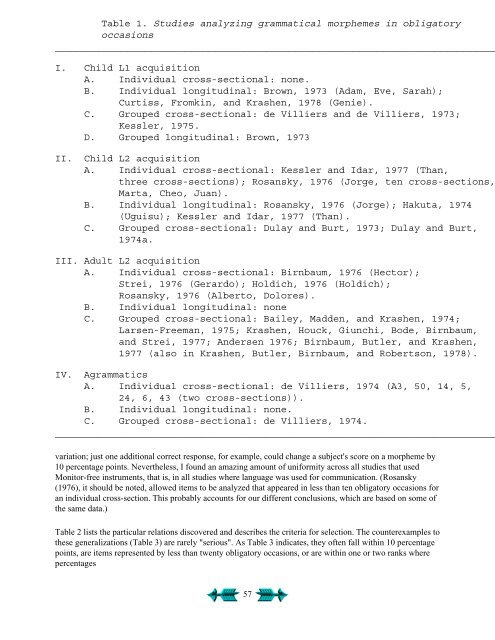Second Language Acquisition and Second ... - Stephen Krashen
Second Language Acquisition and Second ... - Stephen Krashen
Second Language Acquisition and Second ... - Stephen Krashen
You also want an ePaper? Increase the reach of your titles
YUMPU automatically turns print PDFs into web optimized ePapers that Google loves.
Table 1. Studies analyzing grammatical morphemes in obligatory<br />
occasions<br />
____________________________________________________________________________<br />
I. Child L1 acquisition<br />
A. Individual cross-sectional: none.<br />
B. Individual longitudinal: Brown, 1973 (Adam, Eve, Sarah);<br />
Curtiss, Fromkin, <strong>and</strong> <strong>Krashen</strong>, 1978 (Genie).<br />
C. Grouped cross-sectional: de Villiers <strong>and</strong> de Villiers, 1973;<br />
Kessler, 1975.<br />
D. Grouped longitudinal: Brown, 1973<br />
II. Child L2 acquisition<br />
A. Individual cross-sectional: Kessler <strong>and</strong> Idar, 1977 (Than,<br />
three cross-sections); Rosansky, 1976 (Jorge, ten cross-sections,<br />
Marta, Cheo, Juan).<br />
B. Individual longitudinal: Rosansky, 1976 (Jorge); Hakuta, 1974<br />
(Uguisu); Kessler <strong>and</strong> Idar, 1977 (Than).<br />
C. Grouped cross-sectional: Dulay <strong>and</strong> Burt, 1973; Dulay <strong>and</strong> Burt,<br />
1974a.<br />
III. Adult L2 acquisition<br />
A. Individual cross-sectional: Birnbaum, 1976 (Hector);<br />
Strei, 1976 (Gerardo); Holdich, 1976 (Holdich);<br />
Rosansky, 1976 (Alberto, Dolores).<br />
B. Individual longitudinal: none<br />
C. Grouped cross-sectional: Bailey, Madden, <strong>and</strong> <strong>Krashen</strong>, 1974;<br />
Larsen-Freeman, 1975; <strong>Krashen</strong>, Houck, Giunchi, Bode, Birnbaum,<br />
<strong>and</strong> Strei, 1977; Andersen 1976; Birnbaum, Butler, <strong>and</strong> <strong>Krashen</strong>,<br />
1977 (also in <strong>Krashen</strong>, Butler, Birnbaum, <strong>and</strong> Robertson, 1978).<br />
IV. Agrammatics<br />
A. Individual cross-sectional: de Villiers, 1974 (A3, 50, 14, 5,<br />
24, 6, 43 (two cross-sections)).<br />
B. Individual longitudinal: none.<br />
C. Grouped cross-sectional: de Villiers, 1974.<br />
____________________________________________________________________________<br />
variation; just one additional correct response, for example, could change a subject's score on a morpheme by<br />
10 percentage points. Nevertheless, I found an amazing amount of uniformity across all studies that used<br />
Monitor-free instruments, that is, in all studies where language was used for communication. (Rosansky<br />
(1976), it should be noted, allowed items to be analyzed that appeared in less than ten obligatory occasions for<br />
an individual cross-section. This probably accounts for our different conclusions, which are based on some of<br />
the same data.)<br />
Table 2 lists the particular relations discovered <strong>and</strong> describes the criteria for selection. The counterexamples to<br />
these generalizations (Table 3) are rarely "serious". As Table 3 indicates, they often fall within 10 percentage<br />
points, are items represented by less than twenty obligatory occasions, or are within one or two ranks where<br />
percentages<br />
57











